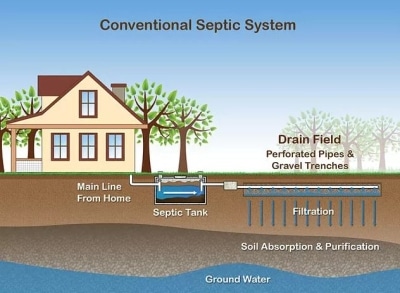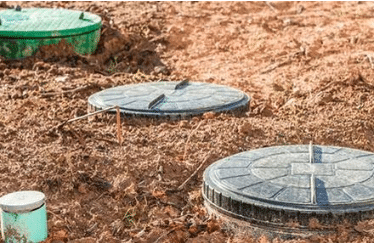How to Find Your Septic Tank
Over time, all septic tanks fill up with solids and require pumping to continue working as they should. Often, septic tank lids are at ground level. In most cases, they have buried anywhere from four inches to four feet underground. If you’ve just bought the home and you don’t know where your septic tank is located, this guide will provide information on how to find your septic tank.

Handy Hint: While every property is different, septic tanks are almost always large and heavy to install. For that reason, and due to the fact that it requires regular pumping, you’re bound to find it in an area that is accessible by a large truck.
5 Ways to Find Your Septic Tank
1. Consult Municipal Records. Probably the easiest way to find your septic tank is to consult the municipality’s building plans for your property. The company that installed the septic tank should have filed an application, which should contain diagrams and dimensions which will allow you to find the exact spot where the septic tank is installed.
2. Search for Highs and Lows. Most septic tanks are installed in such a way that they are inconspicuous. After a few years, grass may grow over the area, but you may notice unexplained low or high spots that might be indicative of a buried septic tank.
3. Toe the Line. Your septic tank will most certainly be installed along the main sewer line that runs out of your home. Look for the 4-inch sewer that exits the crawl space or basement, and locate the same spot outside the home. Septic tanks are usually located between ten to 25 feet away from the home. Insert a thin metal probe into the ground every few feet, until you strike polyethylene, fiberglass or flat concrete. When you do, that’s your septic tank!
4. Find the Lid. A good way to find the lid is to probe around until you can find the perimeter of the rectangle. If your septic tank was installed after 1975, it will probably have two polyethylene or fiberglass lids centered at opposite sides of the perimeter. Older tanks will typically have a 24-inch concrete lid right in the center of the tank. Excavate in those locations to reveal the lids.
5. Call the Pros. No one other than a professional septic tank specialist or master plumber should attempt to open the septic tank lid. Concrete lids will require special lifting tools. Once opened, the tank will emit toxic fuels, and it can be dangerous. A fall into an open septic tank can be fatal.
To save yourself trouble finding your septic tank in future, consider marking the spot once the tank has been pumped out by the professional plumbers. Create your own diagram of your yard, which you can keep with your other house documents. Consider embedding a specific patio tile in the ground on the spot where the septic tank is located.
There you have it! If you’ve been wondering how to find your septic tank, you now have five options, which should make it easier than ever. Contact us today to schedule a plumbing service in Bastrop County!





